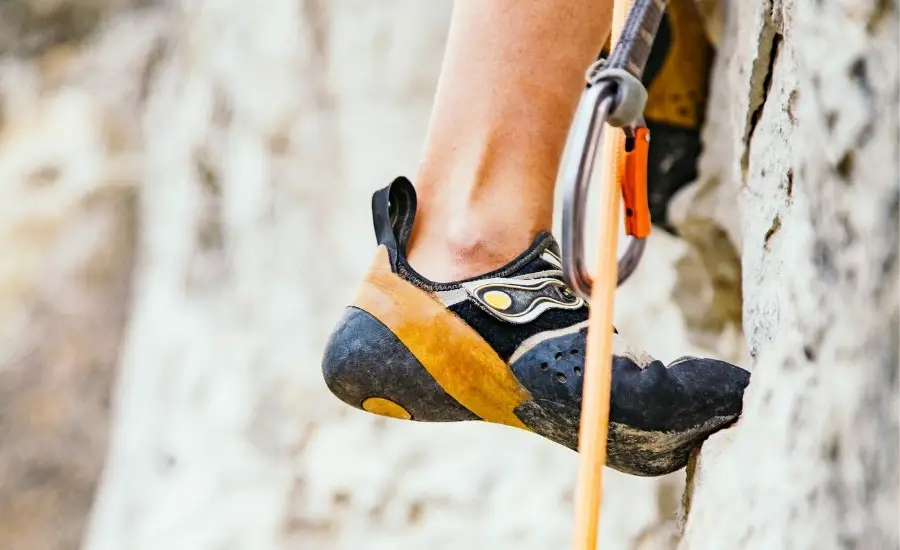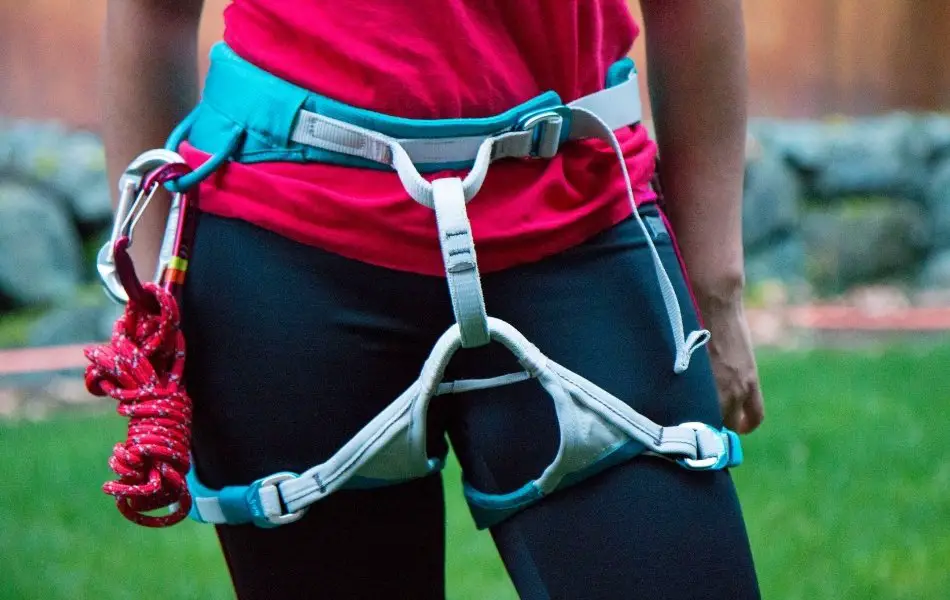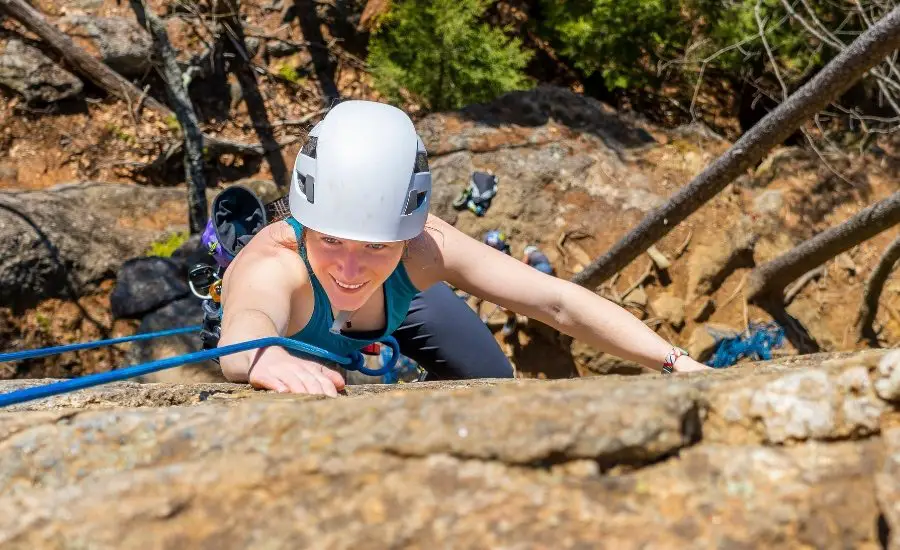Knowing approximately how long each piece of climbing gear lasts provides climbers with a general idea of when they may want to start seriously considering replacing their current gear. Some climbers opt to retire their gear after a certain length of time even if it still appears to be in good condition just to be cautious.
In general, most pieces of climbing gear will last a climber between 2 and 5 years with moderate use. The type of gear, quality of its materials, amount of use, care and storage of it, and the environment it is used in all affect how long it will last.
Each type of climbing gear and how long you can expect it to last depend on a wide variety of different factors. This article explains what primarily affects the lifespan of each piece of climbing gear and how long you can expect each item to last depending on how much you use it.
Expected and Maximum Lifespan of Climbing Gear
Each piece of climbing gear will last a climber a different amount of time. No two pieces of gear will have exactly the same lifespan. That said, some gear pieces such as ropes and harnesses are typically used at the same time and made of materials with similar durability materials.
The table below details the expected and maximum lifespan for climbing gear with moderate use (approximately once or twice a week):
| Climbing Equipment | Expected Lifespan (Moderate Use) | Maximum Lifespan (Since Date of Manufacturing) |
| Shoes | 6 to 12 months | 20+ years |
| Harness | 2 to 3 years | 10 years |
| Rope | 2 to 3 years | 10 years |
| Helmet | 10 years | 10 years |
| Quickdraws | 3 to 5 years | 10 years |
| Crash Pad | 3 to 5 years | 10+ years |
| Approach Shoes | 5 to 8 months | 20+ years |
| Belay Devices | 5 to 10 years | N/A |
| Carabiners | 10 to 15 years | N/A |
The expected lifespan listed above for the gear assumes moderate use (about 2 climbing sessions per week) and proper care. Improper care and increased use of the equipment will decrease the expected lifespan above drastically.
The maximum lifespan for the gear is based on information provided by the manufacturers and may change depending on the specific product. Always check the manufacturer’s specifications to know the exact expiration date for your gear.
In general, soft climbing gear such as harnesses and ropes have a shelf life of 10 years since the date of manufacturing. Hard climbing gear such as carabiners and belay devices do not have a shelf life.
Exceeding the equipment’s maximum life expectancy (even without any indications of wear/damage) is very dangerous. Climbing gear needs to be in good condition to function properly and keep climbers safe. Exceeding the maximum lifespan is gambling with your own safety.
Do not climb with any gear that is expired or you believe could be damaged. When in doubt, retire your climbing gear immediately or bring it to an expert and have them inspect it. Never climb with gear that you notice a defect in.
The expected lifespan of each piece of gear listed above and what the main factors are affecting that lifespan are discussed further in the article below.
Climbing Shoe Lifespan

Climbing shoes, while necessary, are not the most important piece of climbing gear where safety is concerned. Ropes and harnesses are much more important than shoes to make sure that they are in proper working condition and undamaged.
Climbers who climb everyday can run through a pair of climbing shoes in less than 6 months. On the other hand, climbers who only go a few times each year may have the same pair of shoes for over 5 years. On average, climbing shoes will last approximately 6 to 12 months with moderate use.
Climbing outside subjects your shoes to environmental conditions not found indoors which in turn decreases their life. The type of rock and how abrasive it is will also play a factor in this. In addition to the environmental factors, having poor footwork will cause your shoes to scrape against the holds/wall more frequently and wear out quicker.
The rubber sole of the climbing shoes (bottom of the toe box) is typically the first part of the shoe to become worn out. If the sole is worn through, the rand will be the next part to go. Soft climbing shoes are less durable than stiffer climbing shoes due to the different rubber composition.
You can extend the lifespan of your climbing shoes by getting them resoled once the rubber soles start to wear thin. If you are taking proper care of your shoes, they can potentially be resoled 5 or more times. That said, resoles are not always the answer. To see if getting a climbing shoe resole is worth it for you, check out my article linked here.
If you are interested in learning more about the lifespan of climbing shoes and how to extend it, check out my article that discusses this topic in depth.
Climbing Harness Lifespan

Climbing harnesses are one of the pieces of climbing gear that is responsible for catching you during a fall. As such, you need to inspect and make sure your harness is in good condition each time before you use it. If you notice that your harness is damaged you need to replace it immediately. If you are in doubt, toss it out.
On average, climbing harnesses will last between 2 and 3 years with moderate use. Climbers who use their harness daily will likely need to replace it within a year. Any climbing harness manufactured over 10 years ago should be retired immediately.
The fall severity, weight of the climber, and environment the harness is being used in play huge roles in the lifespan of climbing harnesses. Even taking just one extreme whipper can damage the harness and require it to be retired. In addition to this, frequently using harnesses outdoors will shorten their lifespan when compared with only using them in a gym setting.
If you are interested in learning more about the lifespan of climbing harnesses and how to extend it, check out my article that discusses this topic in depth.
Climbing Rope Lifespan
Climbing ropes, like harnesses, are pieces of gear that can result in catastrophe if they fail. As such, inspecting them before each use is incredibly important.
On average, climbers who use their ropes once or twice a week will end up needing to retire and replace them approximately every 2 to 3 years. Climbers using their rope on a daily basis will likely need to replace their climbing ropes within a year.
Certain features of a climbing rope will play into how long it will last. On average, thicker ropes are more durable and longer lasting than their thinner counterparts. In addition to this, ropes with higher fall ratings do a better job at withstanding the cumulative wear of falls than lower fall rated ropes.
How well ropes are cared for and where you store them play a large role in how long they are able to maintain their integrity. Rope bags are a popular way to help keep climbing ropes clean and stored properly. That said, they are not a necessity for every climber by any means. Check out my article to see if a climbing rope bag would be worth it for you.
If you are interested in learning more about the lifespan of climbing ropes and how to extend it, check out my article that discusses this topic in depth.
Climbing Helmet Lifespan

Unlike other pieces of climbing gear, helmets typically do not need to be replaced prior to the manufacturer recommended “expiration date” of 10 years. This is because the helmet is not constantly rubbing against anything or catching your falls.
That said, there are certain things will will require you to replace your helmet before that 10 year mark pops up. If you notice that the interior foam has been damaged or a major dent in the outer shell then your helmet needs to be replaced immediately.
Because climbing helmets last so long, it is worthwhile to make sure you are getting a good one. Why buy a helmet you don’t like and end up replacing when you could get one that you love that will lat you for a decade? Check out which climbing helmets I think are the best bang for your buck.
Quickdraw and Carabiner Lifespan
Quickdraws are a unique piece of climbing gear as they are made up of dogbones and carabiners. Dogbones are a piece of soft climbing gear whereas carabiners are hardware. As such, their components typically last different amounts of time.
Dogbones typically last between 3 and 5 years of moderate use and have a shelf life of 10 years. Carabiners typically last between 10 and 15 years of moderate use and do not have a shelf life.
Therefore, quickdraws as a whole will typically last between 3 and 5 years of moderate use if the dogbone is not replaced. Replacing the dogbone every 3 to 5 years will extend a quickdraw’s lifespan until the carabiners wear out.
If you are interested in learning more about the lifespan of quickdraws, check out my article that discusses this topic in depth.
Crash Pad Lifespan
On average, crash pads will last between 3 and 5 years with moderate use. Crash pads that are only used on occasion can last over 10 years assuming they are properly stored and maintained.
The longevity of a crash pad really comes down to how well they are maintained and how many falls they have taken. Dragging your pad across the ground or positioning it on sharp rocks will rip holes in the exterior and can damage the interior foam if they are not repaired.
The interior foam of pads can only handle so many falls before it begins to get worn out and become no longer effective. Falling on a pad without any good foam is a sure way to hit the hard surface underneath it and potentially get injured. Performing a jump test is always a good way to see if your crash pad will be able to catch your fall properly.
If you are interested in learning more about the lifespan of crash pads and how to extend it, check out my article that discusses this topic in depth.
Approach Shoe Lifespan
Approach shoes may not be necessary for every climber out there. In fact, I would argue that a lot of climbers can get bye without owning a pair of approach shoes. That said, they may be extremely worthwhile for some. Check out my article to see if getting a pair of approach shoes would be worth it for you!
On average, approach shoes will typically last between 300 and 500 miles of use. If we assume a moderate use of 15 miles per week, this comes out to be a lifespan between 5 and 8 months.
That said, some climbers may run through a pair of approach shoes well within 3 months while others may not for a couple years. It really depends on how many miles a week you will be putting on them along with the type of approach shoe being used.
If you are interested in learning more about the lifespan of climbing shoes, check out my article that discusses this topic in depth.
Belay Device Lifespan
Belay devices are a piece of climbing hardware and as such do not have a shelf life per se. That said, they will wear down with use and eventually need to be replaced. They are another piece of climbing gear that should be inspected before every use as just a single sharp edge can lead to your rope becoming irreparably damaged.
On average, belay devices will last between 5 and 10 years with moderate use. Belay devices used daily will typically need to be replaced within 3 years due to excessive wear.
In general, belay devices will need to be replaced once they have become damaged such as:
- Have 1 mm of wear
- Have sharp edges
- Fallen from a distance of 15 feet or more
- Have noticeable knicks or cracks
As with some of the other pieces of climbing gear, if you are in doubt of a belay device’s integrity, do not use it. Unlike other pieces of important climbing gear, belay devices are relatively cheap and easily replaceable. This gives you absolutely no reason to use a worn out and bad belay device.
